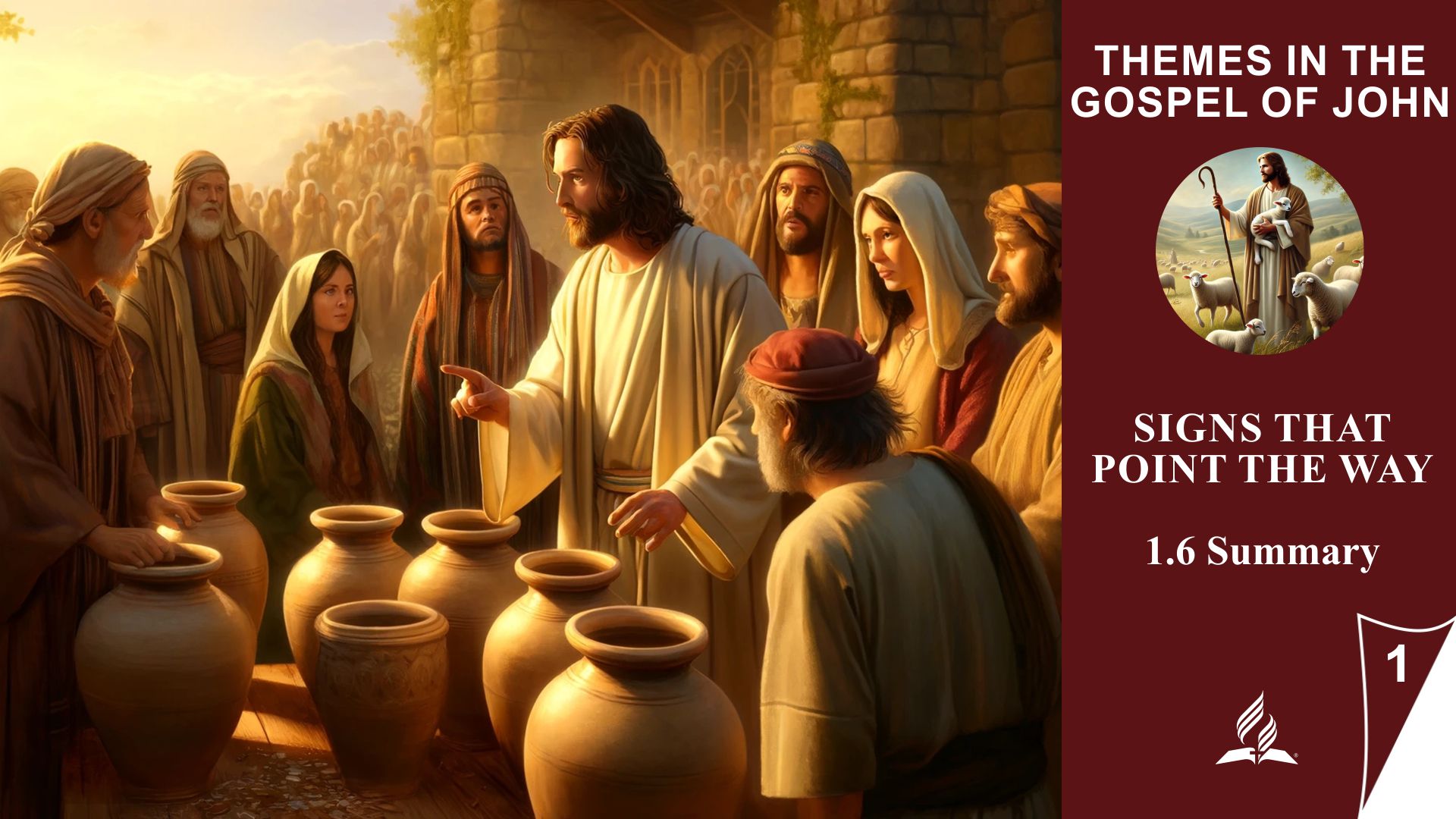


1.6 Summary
Miracles That Create Faith
Lesson 1 focuses on the miracles of Jesus, which John describes in his Gospel as “signs.” These miracles not only serve to demonstrate Jesus’ divine power but also to strengthen people’s faith and point them to Jesus’ true identity as the Son of God. John uses the miracles to emphasize that Jesus is more than a prophet or teacher—He is the Messiah and the Savior sent by God to save humanity.
-
The Miracle at Cana (John 2:1–11) – The First Sign: The first miracle John describes is the transformation of water into wine at the wedding in Cana. This miracle demonstrates Jesus’ power over creation. However, it is not just a demonstration of His ability to solve a problem but holds deeper significance: it reveals Jesus as the one who brings joy and abundance. For the disciples, this was a decisive moment that solidified their faith in Him. The miracle portrays Jesus as the one who satisfies not only material needs but also brings spiritual renewal.
-
The Second Sign in Galilee (John 4:46–54) – Healing from Afar: The second sign John records is the healing of the royal official’s son. The official came to Jesus out of desperation, seeking healing for his seriously ill son. Jesus healed the son without being physically present—only through His word. This miracle highlights the power of faith and Jesus’ authority over life and death. The royal official believed Jesus’ words before seeing the result, demonstrating that true faith does not need to rely on visible evidence but on trust in Jesus’ word. It teaches us that Jesus works even in our absence and that His word is powerful enough to bring about changes in our lives.
-
The Miracle at the Pool of Bethesda (John 5:1–16) – Healing of a Paralyzed Man: The third sign John records is the healing of the paralyzed man at the Pool of Bethesda. The man had been paralyzed for 38 years, waiting for a healing. However, Jesus did not heal him through the traditional means of the pool’s water but solely through His word. This miracle highlights Jesus’ power over illness and the physical condition of humans. Yet, the reaction of the religious leaders to this miracle shows deep hard-heartedness and blindness. They were unable to see the miracle as an expression of God’s mercy but only saw that it occurred on the Sabbath, which they interpreted as a violation of their rules.
-
Jesus’ Claim to Divinity (John 5:16–18) – Conflict with the Religious Leaders: After healing on the Sabbath, the religious leaders opposed Him hostilely because He supposedly broke the Sabbath law. However, Jesus explained that He and the Father act in unity. Jesus claimed the right to work on the Sabbath because God also works on the Sabbath by sustaining the universe. This statement placed Jesus on par with God and challenged the religious leaders, who then accused Him of blasphemy. This conflict shows that Jesus’ miracles were not only signs of His power but also indications of His divine nature.
-
Jesus Defends His Divinity (John 5:19–47) – The Four Witnesses: In a detailed defense, Jesus explains His close relationship with the Father. He does nothing on His own but in complete alignment with God’s will. He clarifies that He has the authority to give life and to judge. To support His claims, Jesus calls upon four witnesses:
-
John the Baptist, who testified about Jesus as the “Lamb of God.”
-
The miracles He performed, which confirm His divine mission.
-
God the Father, who testified at Jesus’ baptism.
-
The Holy Scriptures, which speak of Jesus, yet the religious leaders failed to recognize Him in them.
-
Jesus makes it clear that the Scriptures the leaders study testify about Him. Yet, they refuse to believe Him because their hearts are hardened, and they seek human recognition over God’s glory.
Conclusion: The miracles of Jesus, which John describes as “signs,” hold deeper meaning. They reveal Jesus’ power and mercy and show us who He truly is—the Son of God, the Savior of the world. The challenge for us is to view these signs not merely as historical events but as calls to deepen our faith and fully submit to Christ.
Lesson 1 Has a Profound Connection to Our Daily Life and Faith, Showing How Jesus Through His Miracles Brings Not Only Physical Healing but Also Reveals Spiritual Truths That Should Shape Our Daily Lives. Here Are the Key Connections:
-
Faith as Trust in Jesus’ Workings: The healing of the royal official’s son in John 4 shows that true faith does not depend on the visible. The official believed Jesus’ words without immediately seeing the result. This reminds us in daily life that we often have to trust God’s promises even when we do not see the answer or result immediately. Faith means trusting that Jesus works in our lives, even when it is not immediately obvious.
-
Jesus as the Source of True Renewal: The miracle at Cana, where Jesus turned water into wine, symbolizes that Jesus brings more than just superficial changes. He brings deep renewal into our lives—joy, abundance, and renewal that only He can provide. In daily life, this means recognizing Jesus as the source of our inner needs and challenges. He is the one who fills our lives, even when circumstances are difficult.
-
Prioritizing Compassion and Mercy Over Rules: The healing of the paralyzed man at the Pool of Bethesda teaches us that Jesus prioritizes compassion and mercy over rigid rules and traditions. The religious leaders only saw that Jesus healed on the Sabbath, which violated their regulations, instead of recognizing the mercy and miracle. In our daily lives, this reminds us that our love and care for others are more important than rigid religious or societal norms. People in need should always take precedence over following external regulations.
-
Openness to Jesus’ Divinity and Guidance: The religious leaders rejected Jesus because they did not recognize Him as He truly was—the Son of God. This lesson challenges us in daily life to not only believe in God but also fully submit to Jesus’ guidance. It is not enough to uphold the correct teachings if we are not willing to place our lives under His authority and listen to His voice. This means remaining open to His workings and guidance in every life situation.
-
Allowing God to Work in Daily Life: Jesus’ signs remind us that God works in our daily lives—whether through miracles, guidance, or the healing and transformation He brings into our lives. We are invited to be attentive and recognize God’s action even in the small things of daily life. It is about trusting that God accompanies us in every situation and shows us the way.
Conclusion: The miracles that John describes in this lesson are not merely historical events but point the way to a deeper relationship with Jesus. In our daily lives, this lesson calls us to trust Jesus, submit to His guidance, and prioritize His love and mercy over rigid traditions. We are called to open our hearts to God’s workings and recognize that Jesus is present and active in our lives today—often in unexpected ways.
Trust that Jesus works in your daily life today, even when it is not immediately visible.
Visited 54 times, 1 visit(s) today








